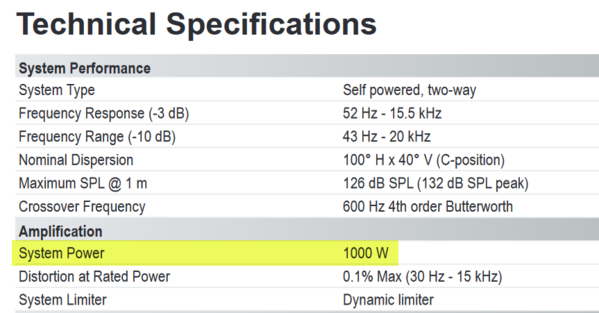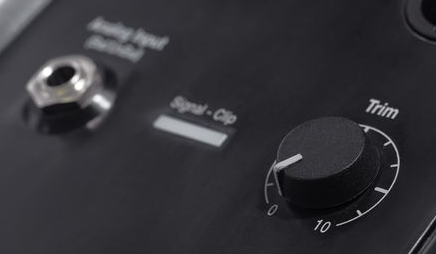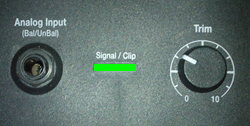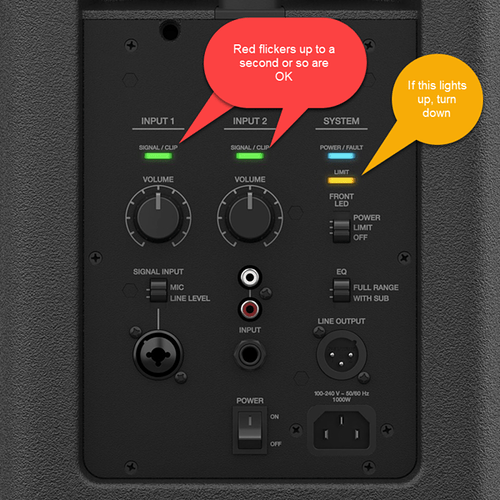I just purchased a F1 full range speaker. It is advertised as 1000 Watts but I have never found specs stating 1000 watts RMS. Is the 1000 watt rating RMS or Peak? I ask this question because my L1 Model II system is rated at 250 250 RMS wattage and it is night and day louder then the F1. What gives??
Must be the settings you're using. I use my L1M2 as a stand alone for smaller gigs, and use it as a stage monitor with my F1's. I've never had to past 10 O'clock on the F1's. I use the T8 mixer
Hi Waltr,
Congratulations on getting the F1 Model 812. You can read the specifications here: Bose F1 Model 812 Technical Data Sheet
Watts are RMS
More importantly, note:
![]()
The L1 Model II is
![]()
What mixer are you using?
The input sensitivity and behavior of the LEDs is different on the F1 Model 812 than other Bose Portable PA gear. Please see this article.
Also, if you are using a T1, please see this article.
T1 ToneMatch® Audio Engine to F1 System
Does that help?
ST
I am using the same mixer for both the L1 Model II that I use for the F1 812. You referred me to the specifications. As in my original post, the specifications don't state whether the 1000 watts is rms or peak. Please read my post.
Hi WaltR
I believe ST answered your question above... (See red pasted text below)
"Hi Waltr,
Congratulations on getting the F1 Model 812. You can read the specifications here: Bose F1 Model 812 Technical Data Sheet
Watts are RMS"
What does it matter? The answer is probably peak, but your perception on loudness is not going to make a difference if is peak or not.
Up Close, the F1 absolutely is louder. Further back, so long as the array is not blocked, the L1 does a better job throwing sound further b/c of the longer array.
It is not night and day like you describe though.
I can tell you that the power supply and amps in the F1 are far superior in regards to efficiently,
They draw less than my L1 setup on typical music playback at pretty high dance volumes.
What does it matter you ask? First of all I did a fair comparison with both speakers at first 20 feet from me. Ten 30 feet and finally 50feet. In all cases the L1 Model II was much louder. This really wasn't my point although I did mention it in my original post. I confirmed that with a decibel meter and didn't just do it by ear. Additionally the L1 was much brighter with the same equalization (flat response on my mixer). My point is that no where have I been able to see where Bose has shown in their specifications the mention of rms wattage like they have with the L1 Model II. Yes one post in response did say it was rms but again I haven't seen this from anything Bose has published. You say, what difference does it make, well peak wattage is used by many company's that use this to fool the buyer making it sound like their product produces more power than it really does. I'm not accusing Bose of this. I would just like to hear something from Bose as to why they aren't stating RMS in there specifications. Short of that I will believe that the power rating is substantially less. I didn't mean to cause an argument over this, I was just trying to get my question answered. I'll move on.
The S1 Pro teaches us that wattage doesn’t really matter. The F1 and L1 teach us that not only does wattage not matter, but speaker design is the key.
Look at it this way ... what if we were all hung up on how many liters an engine was thinking that the higher the number was higher the better the car would perform on the highway. We all know that there are many variables in a vihicles performance that have little to do with how many liters the engine is. Of coarse it is a factor, but only one of many that dictates how fast your vehicle go when you stomp on the pedal.
That being said, the watts game is what manufacturers have to deal with as the general public has been trained that it is the main factor in the equation of loudspeaker performance. It plays a roll for sure, but I venture to say it may be the least important number in the equation.
I don't disagree with what you are saying, but....why bother to list 1000 watts if you aren't going to state if it is RMS or peak wattage. If this had been done, we would not be having this conversation. I am disappointed in the approach Bose as taken on this.
Hi WaltR,
It sounds like you want to make sure your F1 Model 812 is performing well and to hear and appreciate the difference between the F1 Model 812 and the L1 Model II.
WaltR posted:What does it matter you ask? First of all I did a fair comparison with both speakers at first 20 feet from me. Ten 30 feet and finally 50feet. In all cases the L1 Model II was much louder. This really wasn't my point although I did mention it in my original post. I confirmed that with a decibel meter and didn't just do it by ear.
You're right to test the outcomes rather than specifications about the internal components (e.g., watts of the power amplifiers).
Additionally the L1 was much brighter with the same equalization (flat response on my mixer).
The EQ changes depending on the position of the flexible array (e.g., Straight, C, J, Reverse J).
My point is that no where have I been able to see where Bose has shown in their specifications the mention of rms wattage like they have with the L1 Model II.
The Technical Data Sheet for the L1 Model II doesn't specify the wattage as RMS either.
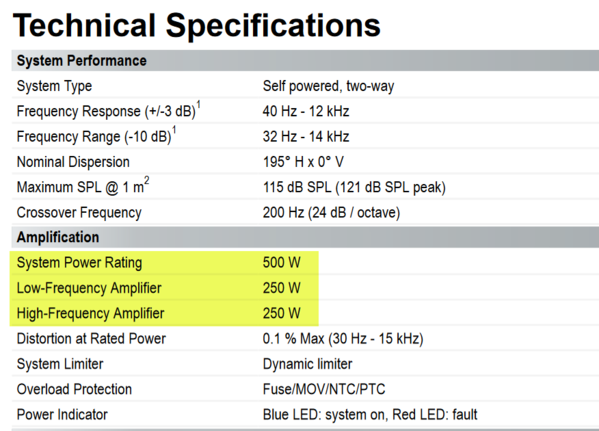
Click the picture above to read the whole document.
Here's an excerpt from the F1 Model 812 Technical Data Sheet
Click the picture above to read the whole document.
The ratings for both are RMS.
Yes one post in response did say it was rms but again I haven't seen this from anything Bose has published. You say, what difference does it make, well peak wattage is used by many company's that use this to fool the buyer making it sound like their product produces more power than it really does. I'm not accusing Bose of this. I would just like to hear something from Bose as to why they aren't stating RMS in there specifications. Short of that I will believe that the power rating is substantially less. I didn't mean to cause an argument over this, I was just trying to get my question answered. I'll move on.
The power rating of the power amplifiers is not going to help you predict the performance of an integrated system. And comparing power ratings is no help at all when it comes to comparing two different systems.
Looking at both documents again, you'll see that Bose lists the System Performance first. The performance you tested with your decibel meter is SPL (Sound Pressure Level).
L1 Model II
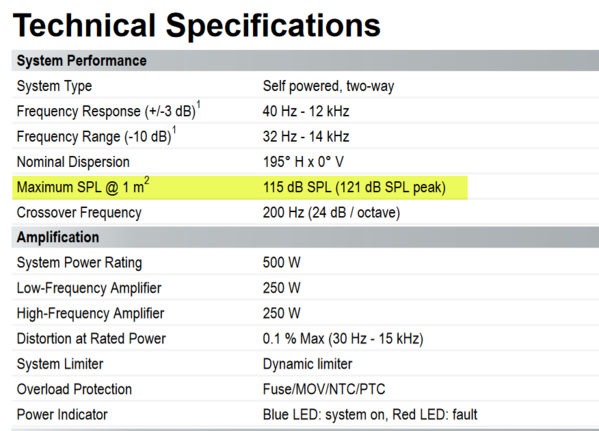
F1 Model 812
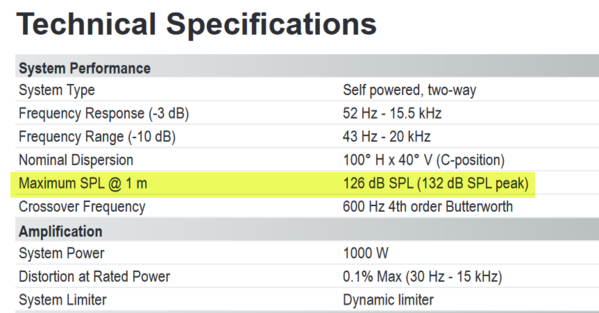
To get the maximum performance from the L1 or F1 system, you need to set the gain staging. The circuitry, input sensitivity, and several other aspects are different in the F1 Model 812 compared to the L1. You can't just set the knobs to the same positions. The input sensitivity of the F1 Model 812 is lower than the L1 Model II. This was done to accommodate the higher output of modern mixers. To compare the outputs of the L1 and F1 Model 812 for a given input (your mixer), you need to optimize the input sensitivity for both units. Here's how to do that.
On the mixer,
- Follow the gain staging instructions for the mixer.
- Adjust the volume of the source device output to the reference or nominal output level.
- On analog consoles this may be marked as unity or 0 dB.
- On digital consoles this may be marked as -18 dBFS[2][3]. The exact value (-18 dBFS to -20 dBFS) may vary depending your location[4].
- Refer to the manual for the source device for details.
- If the source device does not have metering or indicators, set the output as high as you can without hearing distortion or seeing red indicator lights.
- Play some prerecorded music at the highest levels you would in a live situation.
Assuming your mixer has balanced outputs, use a balanced cable to connect to the loudspeaker you want to test
On the L1 Model II
There is a trim control for the analog input.
- Set the Trim control on the power stand to the 0 (zero) position.
- Connect the audio source to the Analog Input
- Adjust the volume of the audio source to the maximum output without distortion.
- While playing the source, increase the Trim level so that the Signal/Clip indicator glows green or yellow.
- If the Signal/Clip indicator glows red, decrease the Trim level so that it glows only green or yellow.
On the F1 Model 812
- Turn up the Volume Control until you see solid red, and then turn it down a little. Occasional red flickers (up to a second long) are okay. This may start to happen at -5 dB before clipping or with transient peaks. You will see these to warn you when you are approaching clipping. If you see solid red then you may be clipping.
It is completely fine to turn up the Volume well beyond 12:00 o'clock if you need to. If you are using Channel 1 and you can't get the input to get solid red on the SIGNAL/CLIP light, set the SIGNAL INPUT level switch to MIC.
Once you have optimized the gain staging as above, you should find the F1 Model 812 is louder than the L1 Model II at close range. As you get farther away, you will find the loudness of the F1 Model 812 drops off faster than the L1. This is because the L1 has a much longer line array (24 drivers compared to 8).
ST
@WaltR, you'll find that the F1 Loudspeaker is considerably louder than the L1 except perhaps at distance as @ST mentioned due to the line source array configuration of the L1 family of products. The power ratings are irrelevant in light of the performance specifications. With powered speakers, power levels are really just to help you ensure that you have enough AC power to run the speakers at full-volume. "Peak" Power and "Peak" SPL specifications for amplifiers are generally used to help marketers put larger numbers on sell sheets and offer no practical value since the amplifiers and speakers will never reach those output levels during routine service.
The f1 sub is 200watts or- 20%
class d amps didn’t magically become 300% efficient
the packlite is 1.8amps at 125volts = 225watts
thus, the b2 and f1 are nearly identical in power.
the 121db rating for the L1m2 is without a b2, so add 6db. 127db for the m2.
jeeze
